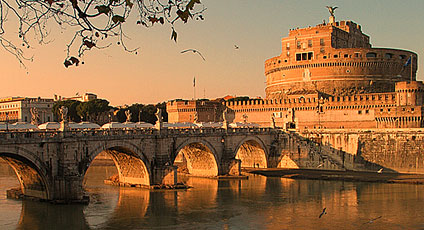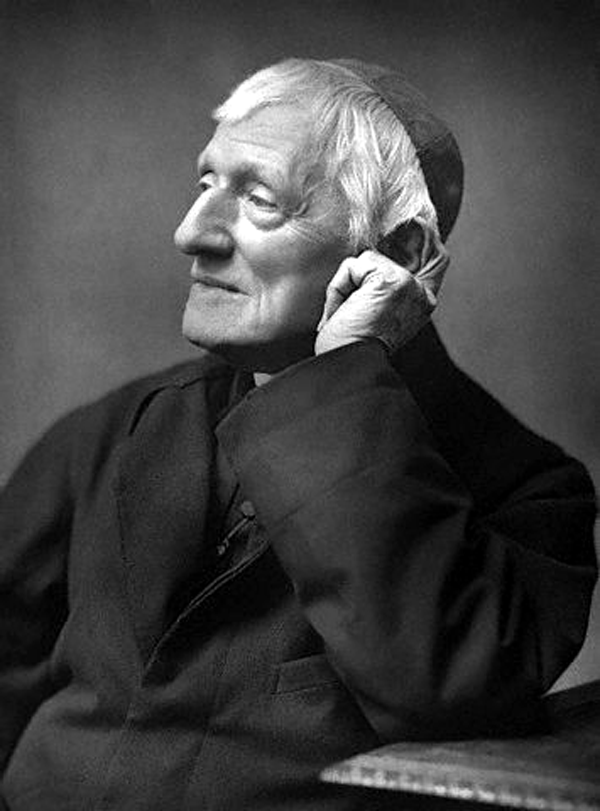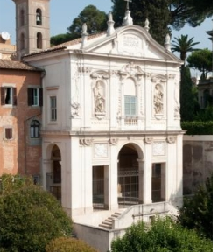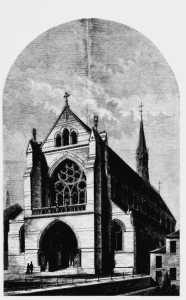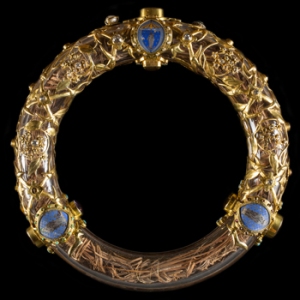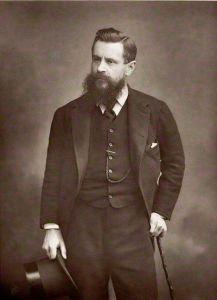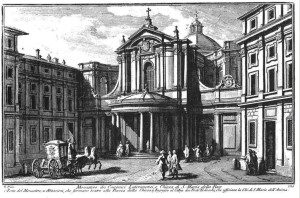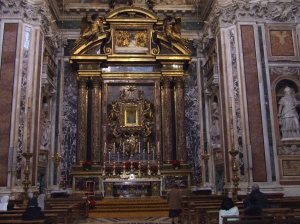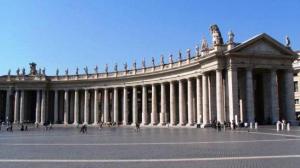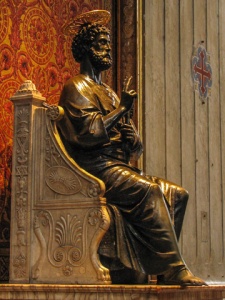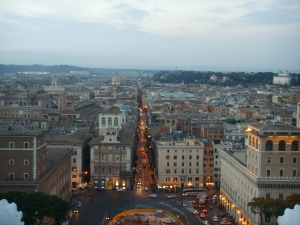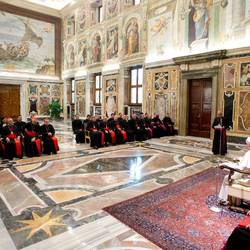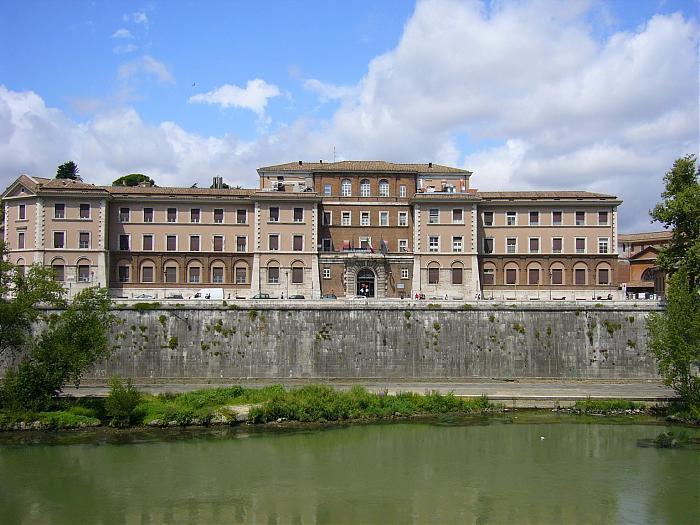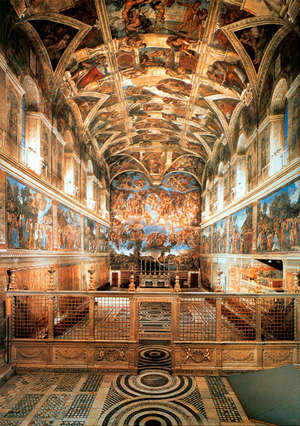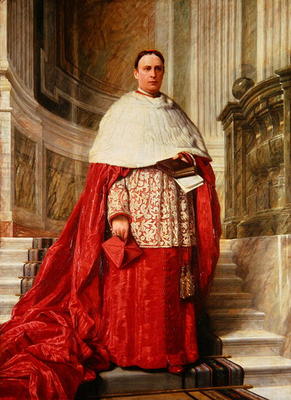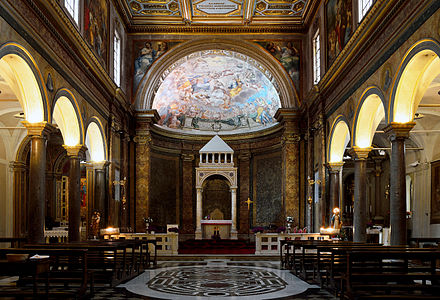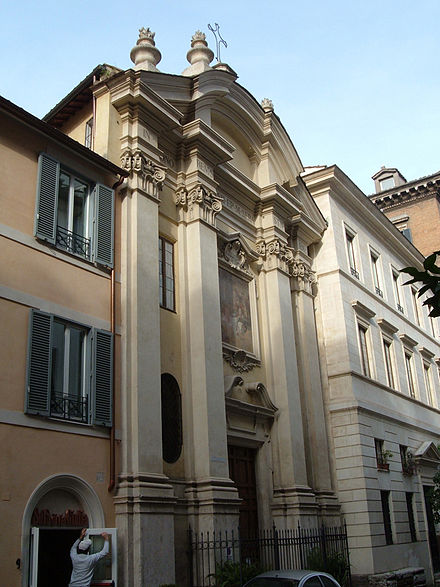ROME. ( FROM OUR OWN CORRESPONDENT )
Rome, May 25, 1878
 The Vatican: The Marquis de Gabriac, the new French Ambassador, and the secretaries and officials of the French Embassy, were driven in three state carriages to the Vatican on the 20th of May. The Marquis was met at the entrance to the Pontifical apartments by two of the Camerieri di Spada e Cappa and conducted to the Sala degli Arazzi. The Pope, attended by his Court in full uniform, and preceded by his cross-bearer, entered the Throne-room about 11 a.m. The Swiss Guards and Pontifical Gendarmes, the Palatine Guard, and a detachment of the Noble Guards were present in the antechambers. Monsignor Martinucci, Prefect of Pontifical Ceremonies, conducted the Ambassador to the Throne-room, and the Acting Master of the Chamber, Mgr. Van der Branden, introduced him to his Holiness. The Ambassador presented his credentials and was cordially received by his Holiness. The Pope then signified his pleasure to make the audience private, and, all other persons withdrawing, he was left alone with the Ambassador. At the termination of this private interview, the secretary and gentle-men of the Embassy were presented to Leo XIII. The Ambassador subsequently paid a visit of ceremony to Cardinal Franchi, the Secretary of State.
The Vatican: The Marquis de Gabriac, the new French Ambassador, and the secretaries and officials of the French Embassy, were driven in three state carriages to the Vatican on the 20th of May. The Marquis was met at the entrance to the Pontifical apartments by two of the Camerieri di Spada e Cappa and conducted to the Sala degli Arazzi. The Pope, attended by his Court in full uniform, and preceded by his cross-bearer, entered the Throne-room about 11 a.m. The Swiss Guards and Pontifical Gendarmes, the Palatine Guard, and a detachment of the Noble Guards were present in the antechambers. Monsignor Martinucci, Prefect of Pontifical Ceremonies, conducted the Ambassador to the Throne-room, and the Acting Master of the Chamber, Mgr. Van der Branden, introduced him to his Holiness. The Ambassador presented his credentials and was cordially received by his Holiness. The Pope then signified his pleasure to make the audience private, and, all other persons withdrawing, he was left alone with the Ambassador. At the termination of this private interview, the secretary and gentle-men of the Embassy were presented to Leo XIII. The Ambassador subsequently paid a visit of ceremony to Cardinal Franchi, the Secretary of State.
On the same day, the 20th, about 300 persons, lay and ecclesiastical, were admitted to audience in the Consistorial Hall and in other apartments of the Vatican. Mgr. Kirby was honoured by a special audience on the 20th to present to his Holiness a richly bound copy of a dissertation, entitled De Rom. Pontificis jure Appellationes excipiendi,&c. This dissertation was written in the year 1835, when the Pious Society of the Priests of St. Paul offered a prize for the best essay on the subject of the right of the Supreme Pontiff to hear appeals from all the faithful without exception. Mgr. Kirby at that time was in holy orders and an alumnus of the Roman Seminary, the Apollinare, and Leo XIII. was then the Rev. Gioacchino Pecci. Both, as well as many other young priests, competed for the prize offered by the St. Paul’s Society. And the prize was won by Father Pecci. But the essay of Father Kirby was next in merit, and was honoured with a second prize, the censors describing it as powerfully written and replete with erudition. Leo XIII. a little time ago reminded Mgr. Kirby of their early days as fellow students, and of the concursus for the prize offered by the Society of St. Paul. The Pope suggested that Mgr. Kirby should print his essay, and gave permission that it should be dedicated to himself. The essay was accordingly searched for, and was printed at the Propaganda Press, and was then presented, as already related, to his Holiness.
On Thursday, the 23rd, the German pilgrims, over 150 in number, were received in audience in the hall of Consistory. The deputation included Count Felix Löe, President ; Counts Louis Arco, Preysing, Maximilian Löe, Korff-Schmising, Hahn, Hoensbroech ; Barons Ketteler, Beckendorff, Vequel, and Reichlin-Meldegg ; and Messrs. Eheberg, formerly Councillor of State, of Munich ; Dr. Lingens, Deputy to the Reichstag; Haas, Director of the Postzeitung of Augsburg ; Dr. Kalt, Mgr. Zehrt, and Mgr. Orsbach. The address, which was in Latin, was read by Count Felix Löe. The Pope replied in Latin, and said he was encouraged by these numerous and influential pilgrimages to hope for better times for the Church, against which and against its head a bitter war was now waged. He was convinced that the same proofs of devotion and loyalty which were so constantly rendered to Pius IX. would be also manifested towards himself. He, for his part, would never cease to return his most cordial love and affection to those who thus boldly laboured in behalf of the Catholic religion. He recommended them to persevere in their works of charity and faith, and especially to promote good education among Catholic children, to fit them for contending against the evils of the age. He prayed for the conversion and reformation of the foes of the Church. He then pronounced the solemn benediction.
At 6 p.m. on the 23rd, his Excellency Bedros Effendi Kujumgian had farewell audience of his Holiness, and left Rome the same evening.
The Earl of Denbigh and Mr. Kenyon had a private audience on Thursday, the 23rd, and in this interview, which lasted for forty minutes, Lord Denbigh presented his Holiness with a beautifully bound copy of the late Mr. Urquhart’s essay on the restoration of public law among nations. The late Mr. Urquhart was a Protestant, but considered the Pope to be the arbiter of all international disputes. Leo XIII. was much interested in this dissertation. Lord Denbigh, on this occasion, obtained a special blessing from the Pope for the members of the Catholic Union and of the Poor School Committee of England. Mr. Kenyon obtained a similar favour for the members of the League of St. Sebastian.
His Eminence Cardinal Cullen, who had spent a few days at Albano, returned to Rome on the 22nd of May, and on the 24th had a private audience with his Holiness, to whom he presented a richly-bound and beautifully illuminated address from the Convent of Loreto, near Dublin. This address was signed by Lady Power of Edermine and by Father Barron, S.J., the Spiritual Director of the Convent.
The German pilgrims: Mass was celebrated on Sunday, May 19th, for the German pilgrims in the church of Sta Maria dell’ Anima, by Archbishop de Neckere, and a sermon was preached by Canon Zehrt, of Paderborn. Cardinals Hohenlohe, De Luca, and Franzelin were present.
The Consecration of Cardinal Borromeo: The archpriest of St. Peter’s, his Eminence Cardinal Borromeo, was consecrated to the archbishopric of Adana in partibus infidelium on Sunday, the 19th of May, in the Sistine chapel, by his Holiness Leo XIII., assisted by Archbishop Sanminiatelli, his private almoner, and Bishop Marinelli, the sacristan of the Vatican. The function began at 8:30a.m., and terminated a little before 11 a.m. Admission to the Sistine was by ticket of invitation. The Princess of Thurn and Taxis, with her children, were in the royal tribune, and the Ottoman Envoy, Bedros Effendi Kujumjian, and his son, Ohannes Bey, were in the seats set apart for diplomatists. Cardinals Sacconi, Randi, Chigi, and Franchi were present. The Earls of Denbigh and Gainsborough, Lady Edith Noel, Mr. Kenyon, Mr. Hartwell Grissell, and many of the English deputation were invited to the ceremony. After the functions were concluded the Holy Father proceeded to the private library, where tables were laid for refreshments for the distinguished visitors. At one of these tables his Holiness sat, having on one side Cardinal Borromeo, and on the other the Princess of Thurn and Taxis. At this table the other Cardinals who had attended the consecration were seated. Cardinal Borromeo wore on his breast a splendid pectoral cross of gold, adorned with rubies, diamonds, and emeralds, the gift of the Holy Father.
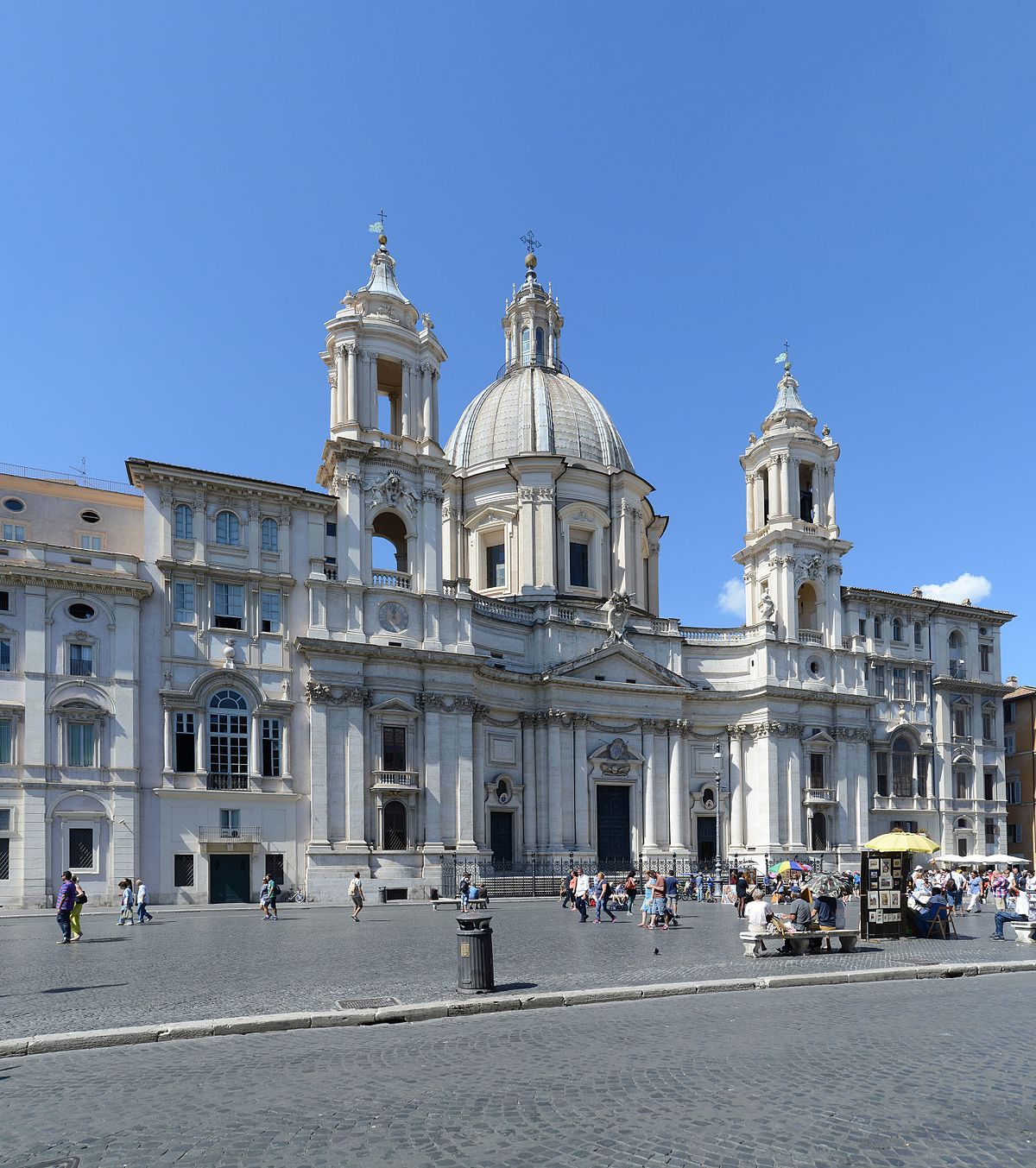
Marriage of Prince Colonna: On Monday, the Prince of Avella, Don Fabrizio Colonna, and Donna Olympia, sister of Prince Doria, were married in the church of St. Agnes in Piazza Navona, by his Eminence Cardinal di Pietro, Dean of the Sacred College and Camerlengo. Monsignor Cataldi officiated as Master of Ceremonies. Prince Alessandro Torlonia and the Duke of Marino acted as witnesses for the bridegroom, and Prince Marcantonio Borghese and Prince Don Alphonso Doria were the bride’s witnesses.
Among those present were Prince Giovanni Andrea Colonna, Prince Assistant at the Pontifical Throne, the father of the bridegroom ; Prince Orsini, Prince Assistant at the Throne ; Princess Orsini, Princess Borghese, Prince and Princess di Fondi, Princess Pallavicini, the Duchess of Marino, Duke and Duchess Sforza-Cesarini, Duke and Duchess of Ceri, the Marchesa Sacchetti, Duchess of Rignano, Count and Countess Somaglia, &c., &c. The bride and bridegroom drove to the church in the state carriages of their respective families, and after the solemnisation of the marriage went, according to custom, to the Basilica of St. Peter’s to venerate the tomb of the Prince of the Apostles. The newly-married pair went to the Villa Doria at Albano, and after a few days spent there, left for the Colonna Villa at Capodimonte.
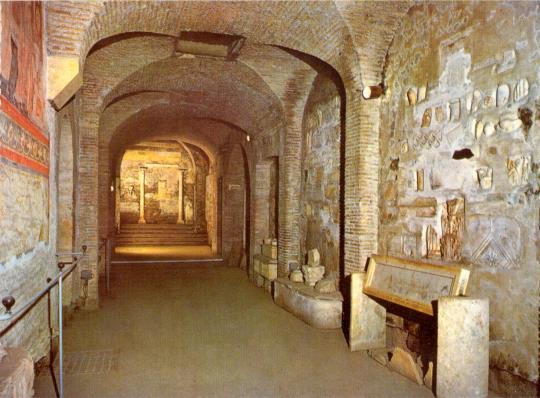
San.Clemente: The following persons lately paid visits to the Church of S. Clemente and were conducted through the subterranean churches by the Very Rev. Father Joseph Mulloolly, the Prior :—Her Royal Highness the Duchess of Genoa, her Royal Highness the Princess of Thurn and Taxis, with her son Prince Max Albert and her daughter Princess Louise. The Earl of Portarlington, Sir Augustus Paget, and Count Corte, the Italian Foreign Minister, were among the recent visitors to this interesting church.
Spanish Pilgrims: A number of Catholic pilgrims from Spain arrived in Rome on the 22nd of May, and will be received in audience on Monday, the 27th.
The Late Count Oreste Macchi: On the evening of the 20th of May the mortal remains of the late Count Oreste Macchi were deposited at Campo Verano, in the vault of the Venerable the Archconfraternity of the Most Precious Blood. The brethren of the Archconfraternity attended the funeral and carried the coffin on their shoulders, reciting psalms and prayers for the repose of the soul of the defunct. Mgr. Luigi Macchi, Maestro di Camera to Leo XIII., the son of the deceased Count, attended the funeral.
The New Bishop of Dunkeld: Dr. George Rigg, Bishop of Dunkeld, in Scotland, was consecrated on the 26th of May by his Eminence Cardinal Howard, in the Church of the Scotch College. The assisting prelates were Mgr. Walter Steins, S.J., Archbishop of Busra, in partibus infidelium, and Vicar-Apostolic of Western Bengal, and Mgr. Giovanni Jacovacci, Bishop of Eritrea,in partibus infidelium, and Secretary of the Sacred Congregation of Esame dei Vescovi. Mgr. Cataldi, Master of Pontifical Ceremonies, acted as Principal Master of Ceremonies, while Mgr. Luigi Sinistri, also a Master of Pontifical Ceremonies, acted as Master of Ceremonies for the Bishop-Elect. Among the persons present at the consecration were Mgr. Van der Branden, Private Chamberlain to his Holiness; Mgrs. Weld, Stonor, Milella, Kirby, domestic prelates to Leo XIII. ; the Father-General of the Redemptorists, with Fathers Douglas and Morgan ; the General of the Dominicans and Father Mullooly, Prior of S. Clemente ; Very Rev. Dr. James Maher ; Very Rev. John Egan, Vice-Rector of the Irish College; the Rev. Dr. O’Callaghan, Rector of the English College • Very Rev. Dr. O’Bryen ; Canon Walsh.; U.S. ; the Very Rev. Dr. Hostlot, Rector of the North American College ; Father Costello ; Mrs. Savile Foljambe, Mrs. Kinloch Grant, the Misses Sperling, Miss Isabel Fane, Miss Senior, Mrs. Vansittart, the Misses Gorman, Mr. and Mrs. Handley, Mrs. Hall, the Misses Steele, Mrs.Martin, Miss Whelan, Mr. William Palmer, Messrs.English and Youngman, Commendatore Winchester, Mr.Douglas Hope, Mr. Hartwell Grissell, Mr. Bliss, Mr. Justice O’Byrne, the Very Rev. Father Keogh, Prior of Sta. Maria in Posterula ; Mrs. Posi, Miss Lewis, &c. After the ceremony the Cardinal and the invited guests were conducted to an apartment in the College, where refreshments were served. Cardinal Howard entertained subsequently to dinner, at his palace, the new Bishop, the assisting prelates, and Cardinals Franchi and Bartolini.
Feast of S. Giro in Portici: The Italian Government has not yet forbidden processions through the streets (at least in Southern Italy) as the Government has done in France, where in Marseilles the Archbishop has been unable to procure permission for the time-honoured processions, though he made a journey to Paris with that intent. In Southern Italy all the rejoicings of the lower classes are so interwoven with religion that a procession of the effigy of the patron saint, accompanied by his relics, forms, as a matter of course, the opening of the Festa ; and even in Naples itself the procession of S. Gennaro retains all its ancient splendour. At Portici, which lies at the very foot of Vesuvius, S. Giro is the patron. He was a native of Alexandria, a doctor by profession, who became a hermit, and was martyred in A.D. 288, in a city called Canopo. After the conversion of the Emperor Constantine his relics were brought to his native city, and were placed in the church of St. Mark. In the time of Pope Celestine I., by order of the Emperor Theodosius, they were brought to Rome, and were venerated in the Church of Santa Prassede. Many centuries elapsed, and the relics, which had attracted but little attention, became an object of special devotion to a great saint, S. Francesco Girolamo, who was inspired by Divine Providence with an extraordinary devotion to S. Giro. At the death of this saint, which occurred in 1716, this devotion bore fruit, and the relics he had procured for Portici were held in high esteem. In 1763, a famine occurred, when Ferdinand IV. was Regent. In the following year food was so dear that the state of suffering became very great, and a plague followed the famine. Then the inhabitants invoked the intercession of S. Giro, doctor of the body as well as of the soul, and innumerable cures were wrought. In 1770, mindful of these favours, a famous artist, Ferdinando Sperandeo, was charged with the task of making a noble statue of S. Giro, and there is a beautiful legend that, while he was thinking how he could best fashion the countenance, the Saint himself appeared to him, and that celestial vision enabled him to produce the statue which was carried in procession last Sunday. It is of beaten silver, and exceeds life-size. The hands, feet, and face, are enamelled in natural colours. The face is truly noble, ascetic, and benign, and the attitude is dignified. In his left hand he holds a crucifix, to which he points with his right. The cranium of the Saint is in an antique reliquary fixed to the pedestal. Here and there along the line of the procession a carpet of flowers had been made with much taste and skill. The procession opened with the band of the town in bright unforms. Then followed the Confraternity called by the Saint’s name, in habits of white merino, with red silk capes, and here and there were carried handsome gold embroidered banners. Next came the Guild of the Immaculate Conception, similarly costumed, only that the capes were blue silk, and all wore large silver badges. The music of the township of St. George (the men dressed in very handsome uniforms and plumes) and that of S. Giovanni Teduccio enlivened the scene. Four thuribles, with incense, were waved before the statue, which was carried under a white and gold satin canopy. As this went past, immense quantities of rose leaves were thrown from the windows of the houses. Crowds of poor people followed, who were reciting a Litany in the Saint’s honour in thanksgiving for favours received through his intercession. In the church of S. Giro is a votive altar of very costly marble, erected in 1778, with an inscription formally declaring him the patron of the town. The devout crowd, the music, flowers, and gay procession, all bathed in a southern sunshine, made a very striking and edifying scene.
The above text was found on p.15, 1st June 1878, in “The Tablet: The International Catholic News Weekly.” Reproduced with kind permission of the Publisher. The Tablet can be found at http://www.thetablet.co.uk .
